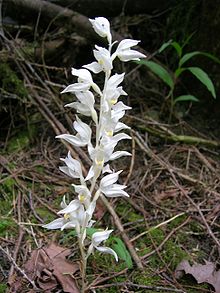| Cephalanthera austiniae | |
|---|---|

| |
| Scientific classification | |
| Kingdom: | Plantae |
| Clade: | Tracheophytes |
| Clade: | Angiosperms |
| Clade: | Monocots |
| Order: | Asparagales |
| Family: | Orchidaceae |
| Subfamily: | Epidendroideae |
| Genus: | Cephalanthera |
| Species: | C. austiniae
|
| Binomial name | |
| Cephalanthera austiniae | |
| Synonyms[1] | |
| |
Cephalanthera austiniae is a species of orchid known as the phantom orchid and snow orchid[2] because the entire plant is white except for a few yellow markings on the flowers.
The orchid is native to the western United States (California, Oregon, Washington and Idaho), and to British Columbia, Canada. Cephalanthera austiniae is the only species of genus Cephalanthera native to the Western Hemisphere.[1][2][3]
This is also the only Cephalanthera species entirely dependent on symbiotic mycorrhizae for its nutrition. This mycoheterotrophic orchid has no chlorophyll, so it makes no energy for itself.
- ^ a b "World Checklist of Selected Plant Families: Royal Botanic Gardens, Kew". wcsp.science.kew.org.
- ^ a b "Cephalanthera austiniae in Flora of North America @ efloras.org". www.efloras.org.
- ^ Biota of North America Program